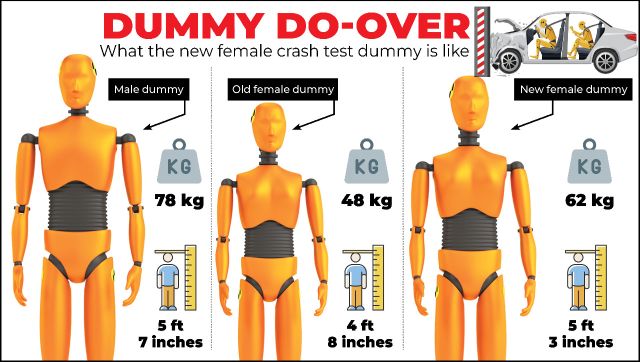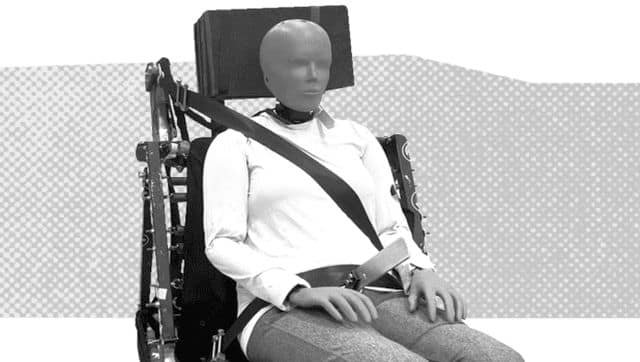Inclusivity and gender equality have become important and gained significance around the world. However, there was still one sector where inclusivity was a distant dream — until now. A team of Swedish engineers have finally developed a female crash test dummy designed to represent an average woman’s body, addressing the historical gender bias in car safety testing. Let’s take a closer look at this new seat evaluation tool — as dummies are technically called — and how this development could be an important milestone. The new dummy Since the 1970s, these mechanical surrogates of human body have been used to determine car safety. Dummies are used by researchers, automobile and aircraft manufacturers to predict the injuries a person might sustain in a crash and design their safety features accordingly. Interestingly, prior to the development of crash test dummies, automobile companies tested using human cadavers, animals and live volunteers. Until now the most commonly used dummy has been based on the average male build and weight. The dummy is based on a standardised 50th percentile male dummy. This equates to a 1.75 m tall man weighing 78 kg which is significantly taller and heavier than an average women. It is important to note that currently there is a scaled-down version of the male one used as a proxy for women on some occasions. In fact, female crash test dummies are not mandated to be used in most tests. The current dummy for women is roughly the size of a 12-year-old girl; at 149 cm tall (4 feet 8 inches) and weighing 48 kg, it represents the smallest five per cent of women by the standards of the mid-1970s. However, in an effort to remove this bias, a Swedish team led by Astrid Linder, the director of traffic safety at the Swedish National Road and Transport Research Institute, came up with a new model of a female crash test dummy. The new dummy stands at an average height of 162 centimetres (5 feet 3 inches) and weighs 62 kg. [caption id=“attachment_11562921” align=“alignnone” width=“640”] Graphic: Pranay Bhardwaj[/caption] Astrid Linder said that it wasn’t just the height and weight of the dummy that has changed. Speaking to NPR, Linder said, “We have a very strong focus on how the torso looks like. And there we have some geometrical differences between males and females, but we also have differences in joint stiffnesses. And females have less muscles and with a lower total strength, which correspond to a lower stiffness between the joints.” The need for a female dummy Over the years, a slew of reports have highlighted how women are at a higher risk of being killed or injured in car crashes. Despite evidence that women’s bodies react differently to car crashes than men’s, the standard dummy used in crash tests till date is one modelled on an average male body’s proportions. A 2019 study by the University of Virginia found that seat belt-wearing women were 73 per cent more likely to suffer serious injuries in a frontal car crash as opposed to seat belt-wearing men. Data from the National Highway Traffic Safety Administration (NHTSA) in the US showed that a woman driver, or belted front passenger, is 17 per cent more likely than a man to be killed in a car crash. US government data also revealed that a woman is three times more likely to suffer whiplash injuries in rear impacts in comparison with a man. While whiplash, on most occasions don’t cause death, it can lead to physical disabilities — some of which can be permanent. Maria Weston Kuhn, who joined the UN’s Global Youth Coalition for Road Safety after a car crash, pointed out that the seat belt “was designed to stop a man’s forward momentum by catching his rigid hip bones. For me, it didn’t. It slid above my hips, pinned my intestine against my spine and ruptured it.” It is this data and testimonials from women drivers that drove Astrid Linder to create the dummy. She was quoted as telling BBC, “We know from injury statistics that if we look at low severity impacts females are at higher risk. So, in order to ensure that you identify the seats that have the best protection for both parts of the population, we definitely need to have the part of the population at highest risk represented.” [caption id=“attachment_11562761” align=“alignnone” width=“640”]
Graphic: Pranay Bhardwaj[/caption] Astrid Linder said that it wasn’t just the height and weight of the dummy that has changed. Speaking to NPR, Linder said, “We have a very strong focus on how the torso looks like. And there we have some geometrical differences between males and females, but we also have differences in joint stiffnesses. And females have less muscles and with a lower total strength, which correspond to a lower stiffness between the joints.” The need for a female dummy Over the years, a slew of reports have highlighted how women are at a higher risk of being killed or injured in car crashes. Despite evidence that women’s bodies react differently to car crashes than men’s, the standard dummy used in crash tests till date is one modelled on an average male body’s proportions. A 2019 study by the University of Virginia found that seat belt-wearing women were 73 per cent more likely to suffer serious injuries in a frontal car crash as opposed to seat belt-wearing men. Data from the National Highway Traffic Safety Administration (NHTSA) in the US showed that a woman driver, or belted front passenger, is 17 per cent more likely than a man to be killed in a car crash. US government data also revealed that a woman is three times more likely to suffer whiplash injuries in rear impacts in comparison with a man. While whiplash, on most occasions don’t cause death, it can lead to physical disabilities — some of which can be permanent. Maria Weston Kuhn, who joined the UN’s Global Youth Coalition for Road Safety after a car crash, pointed out that the seat belt “was designed to stop a man’s forward momentum by catching his rigid hip bones. For me, it didn’t. It slid above my hips, pinned my intestine against my spine and ruptured it.” It is this data and testimonials from women drivers that drove Astrid Linder to create the dummy. She was quoted as telling BBC, “We know from injury statistics that if we look at low severity impacts females are at higher risk. So, in order to ensure that you identify the seats that have the best protection for both parts of the population, we definitely need to have the part of the population at highest risk represented.” [caption id=“attachment_11562761” align=“alignnone” width=“640”] The new crash test dummy created by Dr Astrid Linder and her team in Sweden.[/caption] Why this is important A female crash dummy is significant to the automobile industry. Dr Linder believes that the creation of a female version of a dummy can help shape the way cares are designed in the future. For far too long, cars and their safety features have been designed keeping men in mind, even though women represent almost half of all drivers. Tjark Kreuzinger, a specialist in the field for Toyota, told BBC, “You can see that this is a bias. When all the men in the meetings decide, they tend to look to their feet and say ‘this is it’. “I would never say that anybody does it intentionally but it’s just the mere fact that it’s typically a male decision — and that’s why we do not have (average) female dummies.” While Linder and her team have designed a new dummy, it’s a long way until regulators enforce testing with it, which will translate into greater safety for women. As of now, she and women across the world can take solace that at least one speed bump has been tackled. With inputs from agencies Read all the Latest News
, Trending News
, Cricket News
, Bollywood News
, India News
and Entertainment News
here. Follow us on
Facebook
,
Twitter
and
Instagram
.
The new crash test dummy created by Dr Astrid Linder and her team in Sweden.[/caption] Why this is important A female crash dummy is significant to the automobile industry. Dr Linder believes that the creation of a female version of a dummy can help shape the way cares are designed in the future. For far too long, cars and their safety features have been designed keeping men in mind, even though women represent almost half of all drivers. Tjark Kreuzinger, a specialist in the field for Toyota, told BBC, “You can see that this is a bias. When all the men in the meetings decide, they tend to look to their feet and say ‘this is it’. “I would never say that anybody does it intentionally but it’s just the mere fact that it’s typically a male decision — and that’s why we do not have (average) female dummies.” While Linder and her team have designed a new dummy, it’s a long way until regulators enforce testing with it, which will translate into greater safety for women. As of now, she and women across the world can take solace that at least one speed bump has been tackled. With inputs from agencies Read all the Latest News
, Trending News
, Cricket News
, Bollywood News
, India News
and Entertainment News
here. Follow us on
Facebook
,
Twitter
and
Instagram
.
We finally have the world’s first female crash test dummy and here’s why it’s significant
FP Explainers
• November 3, 2022, 12:21:01 IST
Dr Astrid Linder and her team in Sweden have designed a new crash test dummy representing an average woman, addressing the gender bias in car safety testing. The new model will help making cars safer for female drivers across the world
Advertisement
)
End of Article